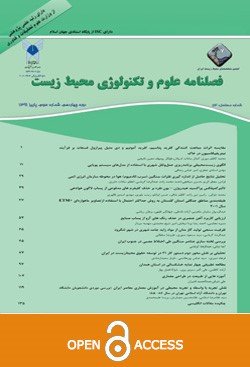Leaching Assessment of PAHs from Oil Contaminated Sites
Subject Areas : environmental management
Akbar Baghvand
1
,
Ali Daryabeigi Zand
2
*
,
Ali Vosoogh
3
![]()
1 - Associate Professor, Environmental Faculty-University of Tehran
2 - Assistant Professor, Department of Environmental Faculty University of Tehran
3 - 3-PhD Student of Civil & Water Engineering, School Of Civil Engineering, IRAN UNIVERSITY OF
SCIENCE AND TECHNOLOGY
Keywords: Polycyclic aromatic hydrocarbo, Soil pollution, Column leaching test,
Abstract :
Introduction: Polycyclic aromatic hydrocarbons are in amongst of the most important environmentalpollutants. Their leaching from soil into groundwater is one of the most important environmentalconcerns. Considering the high volume of activities in oil industry, many sites have beencontaminated with oil compounds in Iran. Since soil remediation costs are very high, making adecision about remediation or not remediation of the oil polluted soils needs a careful assessment.Material & Methods: Column leaching test was applied in the current research as a modern andeffective tool to predict leaching of PAHs from soil. In order to do this procedure, the contaminatedsoil from south of Tehran city (near the oil refractory) were prepared. Then, dried in the air and sievedfrom 2 mm. The material of soil was silt and clay; also had a 1.81 percent organic carbon. The testswere done in glass column with 600 cm3 capacity (6 cm diameter, 21 cm high).Results & Discussion: Results showed that only a small part of available PAHs in solid phase (soil)leached into water and high concentration of PAHs in the solid phase dose not necessary imply seriousgroundwater contamination risk and significant amount of PAHs may stay in the soil for a long time.
1. Krauss, M., Wilcke, W. and Zech, W.2000.Availability of polycyclic aromatic hydrocarbons (PAHs) and polychlorinated biphenyls (PCBs) to earthworms in urban soils. Environmental Science and Technology,Vol.34,pp.4335-4340
2. Grathwohl, P., 1998. Diffusion in Natural Porous Media: Contaminant Transport, Sorption /Desorption and Dissolution Kinetics, Boston/Dordrecht/London: Kluwer Academic Publishers.
3. Kalbe,U.,Berger,W.,Eckardt ,J. and Simon ,F.,2008.Evaluation of leaching and extraction procedures for soil and waste",Waste management,Vol.28,pp.1027-1038
4. Oleszczuk,P. and Baran ,S.,2005.Leaching of Individual PAHs in Soil Varies with the Amounts of Sewage Sludge Applied and Total Organic Carbon Content. Polish Journal of Environmental Studies,Vol.14,pp.491-500
5. Baran S., Oleszczuk P. and Baranowska E., 2003.Degradation of soil environment in post flooding area. Content of polycyclic aromatic hydrocarbons (PAHs) and striating herbicide. Journal of Environmental Science and Health Part B-Pesticides Food Contaminants and Agricultural Wastes, Vol.38, pp.783-796.
6. Zanst, K., 2008.Comparison of Leaching Tests for PAHs
ارسیاتی وشت یَدریکزته اَی آریماتیک ...
11
Contaminated Soils. MSc Thesis, Center for Applied Geosciences, University of Tubingen, Germany.
7. Grathwohl, P. & Van der Sloot, H., 2007. Groundwater risk assessment at contaminated sites (GRACOS): test methods and modeling approaches. In Quevauviller, P. (ed.): Groundwater Science and Policy, pp. 291–315. RSC Publishing, Cambridge, UK.
8. Grathwohl, P. & Susset, B., 2009.Comparison of percolation to batch and sequential leaching tests: Theory and data. Waste Management, Vol .29, pp.2681–2688.
9. Enell, A., Reichenberg, F., Warfvinge, P. & Ewald, G., 2004.A column method for determination of leaching of polycycling aromatic hydrocarbons from aged contaminated soil. Chemosphere, Vol. 54, pp.707–715.
10. Kan, A., Hunter, G., Chen, W., Ward, C. & Tomson, M. (1998) Irreversible sorption of neutral hydrocarbons to sediments: experimental observations and model predictions. Environmental Science and Technology, Vol. 32, pp.892–902.
11. DIN."CEN/TS 14405, 2004. Characteristics of waste –leaching behavior tests-Up –flow percolation
tests (under specified conditions), Brussels: European Committee for Standardization.
12. US EPA, 1986.Method 8310,Polynuclear aromatic hydrocarbons,United States Environmental Protection Agency.
13. Enell, A., Reichenberg, F., Warfvinge, p. And Ewald, G., 2004. A column method for determination of leaching of polycycling aromatic hydrocarbons from aged contaminated soil.Chemosphere, Vol. 54, pp.707-715.
14. Grathwhol, P.and Susset, B., 2009.Comparison of percolation to batch and sequential leaching tests: Theory and data", Waste Management, Vol.29, pp.2681-2688.
15. Zhang, Y., Zhu, S., Xiao, R., Wang, J. and Li, F., 2008.Vertical transport of polycyclic aromatic hydrocarbons in different particle-size fraction of sandy soils", Environmental Geology, Vol.53, pp.1165-1172.
16. Roskam, G.D.and Comans, R.N., 2009.Availability and leaching of polycyclic aromatic hydrocarbons: controlling processes and comparision testing methos.Waste Management, Vol. 29, pp.136-142.

